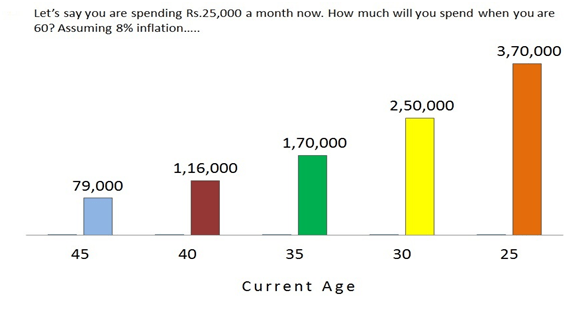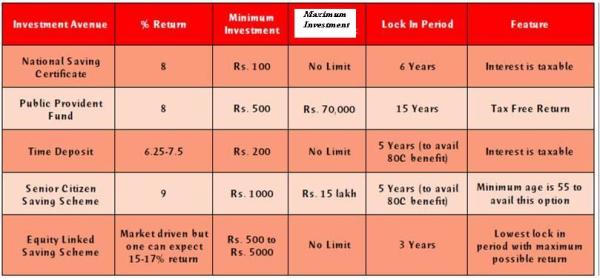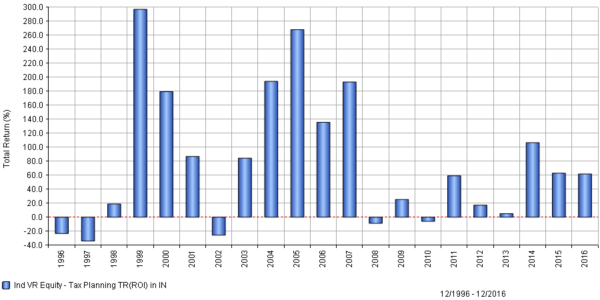Hope you will AGREE with me that your tax saving should be the result of your investment planning & not vice versa. So here fight is not Mutual Fund ELSS (equity-linked saving scheme) Vs PPF (Public Provident Fund) but much bigger than that.
I will agree with you that it’s not that SIMPLE but I promise after reading this post you will be able to take better investment decisions.
I have covered everything that will help you in taking the decision – a simple infographic, an awesome video, the table of comparison, the performance report of ELSS but in a different style & my view as an advisor.
ELSS Vs PPF infographic
Don’t consider it as verdict because we have also shared in earlier post – when not to invest in ELSS

If you want to know basics of Equity Linked Savings Scheme –
Check this post ELSS Funds (But before that check the video below)
Retirement – Mutual Fund Vs PPF
Be frank first question that we must ask our self is WHY we are investing in ELSS or PPF – both provide equal tax benefits under section 80C. It’s not only about TAX – it will also help in achieving our long-term goals. GOAL is the only common ground that I can see – else how we can compare an equity instrument with debt investment. Public Provident Fund (PPF) is always considered as retirement instrument so let’s first try to understand your actual need.
How much to save for retirement? Whether you are in government sector or private sector, whether a professional or businessman there is one goal for which everyone saves money and that is “Retirement”. With the increase in the medical facility and constant increase in the life expectancy, it has become more important to save for retirement. An average Indian spends 20 – 25 years of his life in retirement. Still, a majority of the population do not save enough for this major event.
In the government sector, guaranteed retirement benefits are already available to employees in the form of pension and other benefits which are inflation adjusted, however for an employee in private sector or for a businessman, they have to plan their own retirement with different products available in the market such as Insurance pension plans, Public Provident Fund (PPF), Mutual Funds, etc.
Most of the times when people start thinking about retirement first question which comes into their mind are how much to save for retirement and second- which product to select? To calculate the required retirement corpus is very simple but to select the best out of available products is a very difficult to process. Let us first show you how to calculate required corpus for retirement.
Check – 11 Unusual ways of smart tax planning
How much to save for retirement?
To calculate the value of retirement corpus few inputs is required which are different for every individual like current monthly expenses, age, retirement age, expected rate of return, etc. Suppose Mr. A is 30 years old and his monthly expenses are Rs.25,000, he wants to retire at the age of 60. So considering 8% inflation, his monthly expenses at the age of 60 would be Rs. 2,50,000.
Below image shows how much your expenses would be at the age of 60 as per your current age.

ELSS Vs PPF – Video
Note – Don’t look at the number they keep changing – but important is you understand the power of equity & compounding.
Now the Comparison
I am comparing Equity Mutual Funds (you can consider it as a synonym of ELSS) with other instruments – I have also added Insurance but I don’t suggest to mix insurance & Investment.
Mutual Fund ELSS Vs PPF Vs Insurance Pension Plan
| Equity Mutual Funds | Public Provident Fund | Insurance Pension Plan | |
| Liquidity | MF provides option to redeem on demand, which is extremely beneficial especially during emergency. | First redemption is allowed at the end 7th year which is 50% of the balance at the end of 4th year. | One cannot withdraw money from pension plans. Only option is to either surrender the plan after 3 years or take loan on surrender value. |
| Tax saving | Only Tax saving mutual funds (ELSS) are allowed for deduction under Sec 80C. Redemption in equity mutual funds after 1 year is tax free. |
Investment in PPF account is allowed for deduction under Sec 80c and redemption on maturity after 15 years is also tax free. However premature redemption would be taxable. |
Premium paid towards pension plans are allowed for deduction under Sec 80c. On maturity only 1/3 of the accumulated amount is commuted which is tax free and rest of the amount is paid out in the form of annuity and is taxable. |
| Lock in | ELSS schemes of mutual funds have lock in period of 3 years and no withdrawal is allowed. Many other schemes have different lock in period, however withdrawal is allowed with exit load. | There is an initial lock in period of 15 years and there after every 5 years. However one can withdraw money from the end of 7th year. | Lock in period = term of the policy. However one can surrender the plan or take loan on surrender value after 3 years. |
| Expected returns. | As equity mutual funds are market linked hence no return is guaranteed, however over a long period one can expect a CAGR of 12-15% | Current interest rate is 8% | The bonus issued is generally around 4-5% in insurance policies which is in the form of simple interest. |
| Maximum Investment | No limit | Limit of Rs.1.5 lakh per year. | No limit |
| Safety | Since the money is invested into equity market, the returns are not guaranteed. However the schemes are approved by SEBI and are monitored under strict guidelines. | Since the scheme is backed by the government, safety is not an issue. | The equity exposure in pension plans is nil. Also, insurance schemes are approved under the guidelines of IRDA. |
| Mode of investment. | Through Cheque, DD, NEFT and RTGS. | Cash, Cheque, NEFT. | Cash, cheque, NEFT, Credit Card. |
Check – Best Tax Saving Mutual Fund 2017
Why choose Mutual Funds over PPF and Insurance Pension Plans?
In the above example of Mr. A, total retirement corpus required is Rs. 4.9 Cr. Suppose he chose to save this amount through PPF then required saving per month would be Rs. 30,000 approx. For insurance policy he would be required to pay premium of Rs. 60,000 per month.And for the same corpus if he chose Mutual Funds then he would be required to save Rs. 13,000 approx. The reason why mutual funds require less saving is due to its equity exposure. It can beat inflation and can generate higher rate of return in the long period of 30 years.
ELSS Vs PPF Vs NSC – Comparison
Update – Senior Citizen Savings Scheme rate 8%

Read – when not to invest in ELSS
ELSS Performance – 3 Year Rolling Return
3 years is a very short period for equity but at least this can give you idea about volatility.

My View
While considering retirement planning one should select a product which invests in equity, suits his risk profile, beats inflation and gives tax-free returns. Mutual funds are best as they fulfill the required criteria and offer much-required liquidity option with minimum cost.
Also, mutual funds are successful in creating long-term wealth and offers better flexibility than PPF and Insurance Policies. Please remember, over exposure into one asset class can harm your portfolio in long run. So, one should always invest with the proper asset allocation and review the strategies regularly to get maximum benefits.
Best debt tax saving instrument is PPF – Best equity tax saving instrument is ELSS. Period
Feel free to ask any questions or share your views in the comment section.
You can download ELSS vs PPF PDF from the print friendly button.
Hi, I am running 2k SIP in Axis Long-term Equity (ELSS) since last one year. (invested 24K) Now it is due to renew SIP for next financial year.
As it is not performing well ( return is 9% in one year), Should i Renew with same 2k amount for another year OR should I start in another ELSS fund. My ELSS should me large cap or multi cap. time horizon in 25 years.
I understand judging performance in one year is not good idea. BUT still i am worried to invest moe 24k in 12-month SIPs in AXIS.
your is your view ….
Hello Santosh,
ELSS are not the product of one year so don’t judge any Fund on the basis of one year performance and if you are running a SIP in ELSS Fund than Please continue it for long term because it gives you better returns in longer duration of time.
Whats d best option to invest in 2017 ? PPF or Mutual funds through SIPs’ ?
Will it be a good decision if one invests his full sum of matured PPF amount to Sip in balanced or retirement funds ?
Hello Ranobir,
PPF is a product of 15 years and as we all know that the returns in PPFs are decreasing year on year and returns in ELSS are quite better than PPFs hence if can you take risk than you should start SIP in ELSS rather than PPF but if you want risk free returns than in my view PPF is the option for Retirement Planning.
You should contact a good Financial Planner before making such decision.
Dear hemant Ji,
Thanks for the information of ELLS vs PPF.
I wish to share following.
I am a senior citizen age 72.
I have invested in hybrid fund giving dividend income tax free. mothly/quarterly/yearly
Fund name
1. Birla SL Balance 95 Fund-Quarterly 8.5 % to 9 %
2. Reliance reg. saving Balance Fund -Quarterly 8.5 to 9%
3. ICICI Pru. Balance Advantage Reg. Fund.-monthly 8% to 8.5 %
Like SIP I keep adding fund every month.
regards
kiran parekh
Comments are closed.